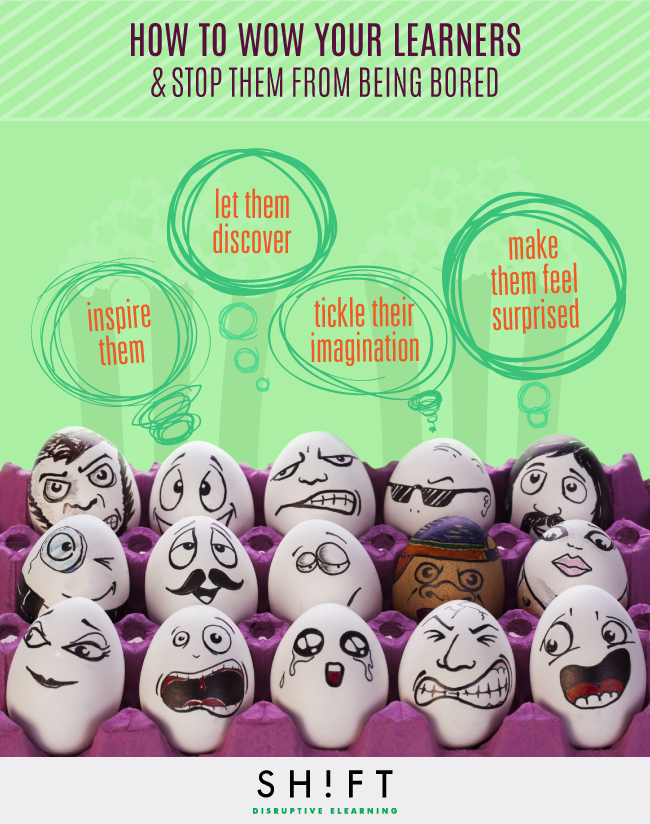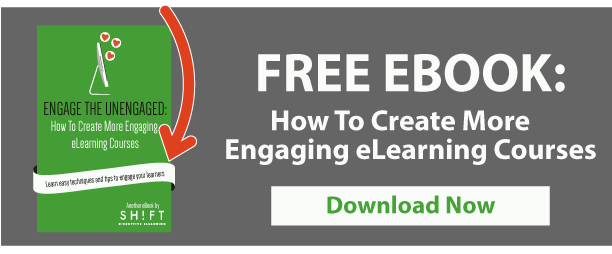Remember those whodunits or the comic books from your school days that you stayed up late to finish? Or those old movies that stirred you so much that you still can't stifle a sob or resist a chuckle when you think about them? Was that an autobiography, a piece of news item, or a meeting that inspired you to ditch a bad habit or take up a cause for life? We all have memories of such stories that touched our hearts and changed our lives. Don't you wish your eLearning courses would touch people's lives in the same way?
Blame it on tight deadlines, stringent budgets, boring (read: technical) content, or dictatorial managers, but most amongst us have created ho-hum courses that have managed to put many learners to sleep. We ourselves cringe when we remember these courses!
So how can you create eLearning courses that wow learners even when the constraints remain in place? How do you create courses that change minds? Here are four proven ways:

#1: Take learners on a journey à la TED Talks.
We love stories! We love going on journeys with people who inspire us to become our better versions. We love to hear about their exploits and how they overcame the odds to emerge as the hero. Think of a TED Talk, and you will get the idea! From weaving in the element of surprise in the story to churning up emotions, a TED Talk packs in relevance and delivers it with compassion and authority to move you deeply. Here's how you can create a TED Talk-like journey in your eLearning course:
- Figure out where the journey starts. This should be the hook that will entice learners to explore your course. Be as crisp as you can be; introduce the course and tell the learners what's in it for them.
- Do not attempt to create a course that will be the one-stop resource on the subject matter, because you cannot. You will only end up creating a hodge-podge where the critical pieces of information are lost in a maze. Identify what you want to teach in your course, and aim to create a stellar learning experience with vibrant and realistic scenarios and relevant examples.
- Develop a tout narrative that holds audience attention.
- Add a human touch because without this, even a well-crafted story fails to touch a chord with the audience.
- Have a hero your audience can relate to. To coax the learner to embark on a (eLearning) journey with you, you have to create a believable role model. Let your hero be in the same life situation as the learner, so the latter feels motivated to follow in his footsteps and emulate his successes.
#2: Employ the "Reveal" Technique
"The audience wants to work for their meal, they just don't want to know that you're making them do that." Filmmaker Andrew Stanton in a TED Talk (He happens to know a thing or two about how the minds of the audience work!) says the audience wants to figure out things for themselves. So don't just dump the facts and the statistics on them; sprinkle some clues and let them find out themselves. "Reveal" bit-by-bit to engage them and keep them interested.
Your corporate audience is no different. They are used to deciphering jargons, reading between lines in their communications, and figuring out charts, diagrams, and tables. They love to think through things before arriving at conclusions, so they will appreciate if you make them ponder first before revealing the details.
#3: Tickle the imagination: What happens next?
This is how all riveting stories work, from the racy crime thrillers to your favorite soap. They tickle your imagination to keep you interested. As an instructional designer, you should challenge the learner to use his imagination and think critically. Engage the brain in the “What happens next?” mindset. The quicker you can do this with your course, the more connected your audience will feel to your message. Their brain won’t be able to help itself.
Go beyond the standard MCQs and drag-and-drop games and create some intellectually-stimulating tasks with the following tips:
- Make the learners work out their gray cells, but do not create such a stiff task that they feel overwhelmed and disheartened.
- Create tasks that mimic reality to keep the learners interested.
- Ask questions that compel learners to reflect. For instance, your question might make the learner tap into earlier experiences, ponder over the learning he has just acquired, and synthesize the two to come up with an answer. Thought-provoking questions help learners engage with the course and keep them guessing about what's coming next.
- Do not let your course turn into an all-you-can memorize exercise. Your audience is intelligent and application-driven. They are not excited at the prospect of memorizing lists and remembering numbers. You have to woo and wow them by creating opportunities for them to create knowledge that is relevant to their needs and professional aspirations.
#4: Weave in jaw-dropping moments
We love surprises; the unexpected grabs our attention like nothing else. Make your eLearning course grab eyeballs and keep the learners hooked by weaving in a "jaw-dropping" moment that takes them by surprise, tugs at their heartstrings, leaves them laughing helplessly, fills them with dread, or moves them to take action.
Here's how to take an ordinary piece of information and package it into an extraordinary idea that jolts your audience and makes them sit up to take notice of your eLearning course:
- Identify one piece of information that your audience is not likely to know. Weave your jaw-dropping moment around it.
- Shun conventions and find a quirky way to present this novel piece of information.
- Weave in an emotion into the story. We human beings are swayed by emotions.
- Remember to be relevant. Use analogies and comparisons to create relevant associations.
- Use visuals to set the mood.
Also see how Bill Gates released a jar of mosquitos into an audience in his Ted talk on some of the world’s biggest problems. This is a jaw-dropping moment.
CONCLUSION:
Creating a wow-worthy eLearning course is a dream all instructional designers harbor. We are not content to create a staid page-turner. Nor are we happy creating courses that try to dazzle the audience with glitzy computer graphics. We want to create courses that change the lives of our audience for the better. Take cues from the above-mentioned creative strategies; be a change agent.
Sources:
Talk Like TED: The 9 Public-Speaking Secrets of the World's Top Minds. Carmine Gallo.








